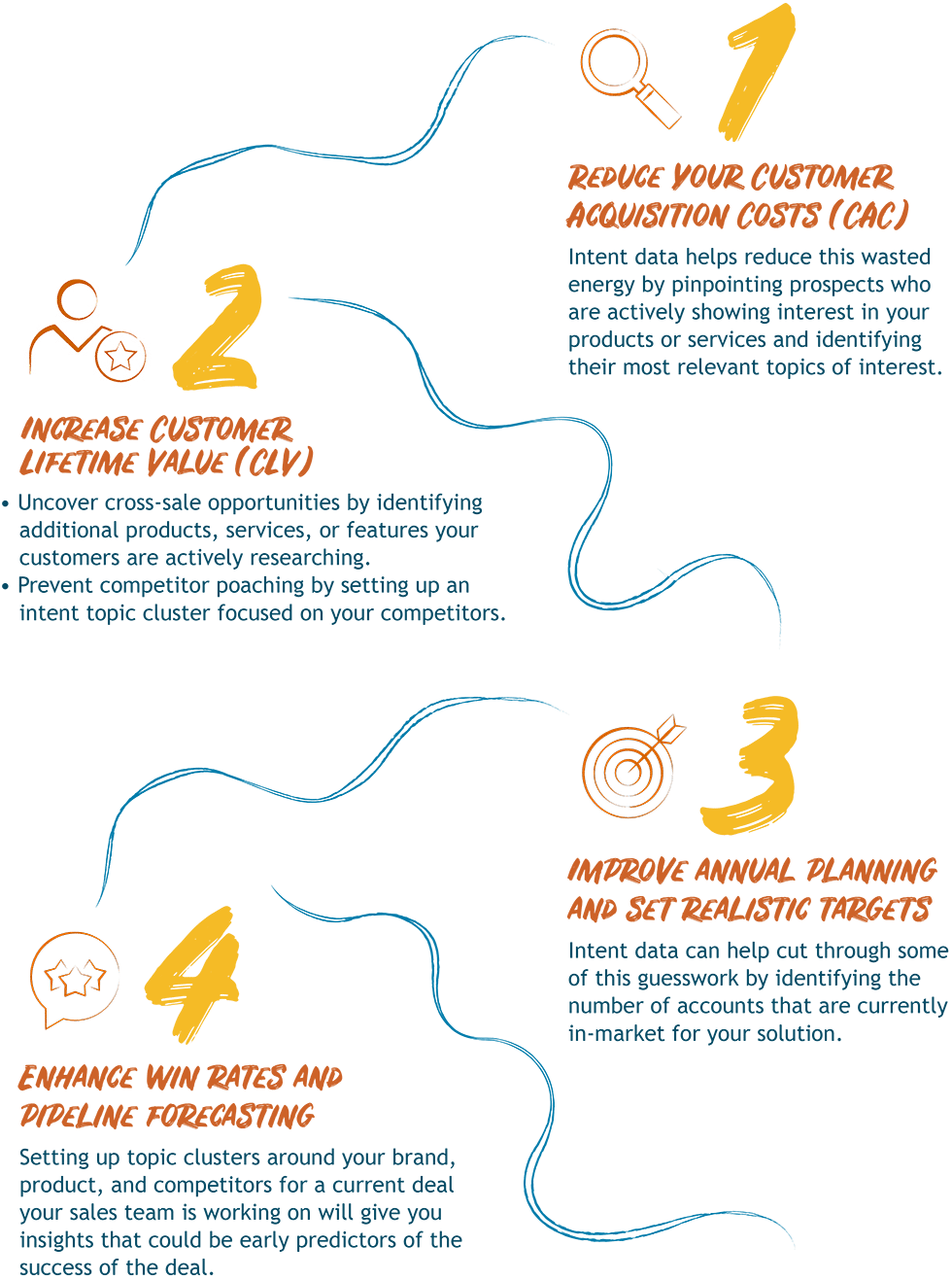4 ways to drive long-term B2B revenue growth with Intent data
Most marketers know that integrating Intent data into your ‘top of funnel’ marketing processes can give a huge boost to your short-term metrics to amplify your B2B revenue growth.
Seeing results like Salesforce’s 300% increase in ad Click-Through Rate isn’t uncommon when Intent data is thrown in the mix.
…but only the savviest of marketers know how to use this same Intent data to unlock incredible benefits across your entire customer lifecycle.
Want to see for yourself?
Top 4 areas you can drive long-term revenue growth with Intent data

1. Reduce Your Customer Acquisition Costs (CAC)
Customer Acquisition Cost is just like it sounds – The cost to acquire a new customer.
The easiest way to calculate your CAC is by dividing your total sales and marketing costs by the total number of new customers.
This means all of the ads and energy put into customers who aren’t in the right stage of the buying cycle (or who simply aren’t interested) increases the acquisition cost of each customer – making your customers more expensive and decreasing your overall profit margin.
Intent data helps reduce this wasted energy by pinpointing prospects who are actively showing interest in your products or services and identifying their most relevant topics of interest. With this knowledge in hand, you can launch highly personalized advertising and sales campaigns that will resonate with your customers.
Using this tactic:
- IBM realized a 41% decrease in cost per customer registration
- Cloudera reduced their cost per website landing by 50%, and
- Hushly saw a 498% jump in CTR, a 79% reduction in CPC, and a 414% improvement in lead conversion rate
2. Increase Customer Lifetime Value (CLV)
Churning ain’t just a way to make butter, it’s also a quick way to destroy your profits.
According to studies cited by Harvard Business Review, retaining your existing customers can be anywhere from 5 to 25% less expensive than trying to attract new customers, and increasing customer retention rates by as little as 5% can increase profits by 25 to 95%.
So, how can Intent data be used to keep your current customers happy and increase their Lifetime Value?
Here are two easy methods:
- Uncover cross-sale opportunities by identifying additional products, services, or features your customers are actively researching.
- Prevent competitor poaching by setting up an intent topic cluster focused on your competitors.
No matter what you do, you can’t completely eliminate customer churn, but, by monitoring your existing customers’ activity level in product and competitive intent topic clusters, you’ll have an early warning indicator that can help you proactively approach clients to provide their desired solutions and/or help increase their satisfaction and prevent churn.
Keeping the customers you already have and introducing them to new and beneficial products and services you offer are two easy ways Intent data can help you increase your customer’s total lifetime value.
3. Improve annual planning and set realistic targets
Here’s the dirty little secret most salespeople don’t want you to know: Forecasts are often just mildly-educated guesses at best.
Start with last year’s revenue, add a dash of hope, a pinch of caution, and finally garnish with the number the boss wants to see.
Thankfully, Intent data can help cut through some of this guesswork by identifying the number of accounts that are currently in-market for your solution.
With a realistic picture of how many accounts will make up your Total Addressable Market (TAM), the average close rate, and the average sale price, you can run a reverse funnel analysis to understand if your forecasts are reasonable, and you’ll have the relevant data and calculations to intelligently discuss your projections with your management or executive team.
4. Enhance win rates and pipeline forecasting
Used correctly, Intent data is like ESP for your sales team.
Setting up topic clusters around your brand, product, and competitors for a current deal your sales team is working on will give you insights that could be early predictors of the success of the deal. For example:
- If your brand and product are trending up throughout the sales process, this means your customer is interested and engaged, and you’re more likely to win the deal.
- If the customer is interested in the product but is trending with higher interest for your competitor, you’re more likely to lose and should investigate other strategies to keep your customer engaged with your brand.
- If the product itself is trending down, it’s more likely that the company has lost interest or has a higher priority and the prospect will likely put the project on hold.
In addition to these indicators, Intent data can also be used to predict pipeline by mapping out the entire buyer journey from the initial search to final conversion. With this data, coupled with factors like firmographic data, you can apply behavioral data points to each stage in the journey, determine possible trends, and even predict deal outcomes earlier in the sales process.
Ready to get started?
Don’t let all of the amazing stats fool you – Intent data is an incredible tool for your entire customer lifecycle, not just the ‘top of funnel’ customer acquisition phase.
These strategies are more advanced, but the effort is well worth the reward –
Here is the best way to get started using Intent data to grow your long-term revenue quickly and successfully:
- Establish benchmarks for the metrics you’re looking to improve
- Start with 1 or 2 items from this list (Don’t attempt all 4 at once!)
- Reach out to your friendly Bombora team for helpful tips and support
Remember: When you use Bombora you’re not alone. We’re here to help!


